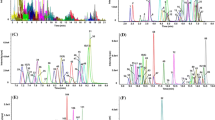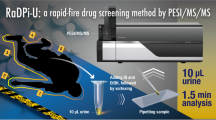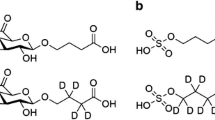Abstract
In recent years, drug-facilitated crime (DFC) has become an increasing problem. A minimum list of 80 analytes to be monitored in such cases has been proposed by the Society of Forensic Toxicologists (SOFT) including the recommended minimum performance limits (RMPL). In the present study, two liquid chromatography-tandem mass spectrometry-based screening procedures, one in positive (method I) and one in negative (method II) electrospray ionization mode were developed and validated. Gradient elution was performed on a ZORBAX Eclipse XDB-C18 column after protein precipitation of the urine samples. Detection was carried out in the scheduled multiple reaction monitoring (MRM) mode monitoring two transitions per compound. A total of 100 analytes (91 basic in method I and nine acidic in method II) could be identified using the described procedure. No interferences were observed in 30 tested blank urine samples. The RMPLs were achieved for all analytes and ranged from 1 ng/mL for fentanyl to 10 μg/mL for γ-hydroxybutyrate (GHB). Matrix effects (ME) were evaluated using the same 30 urine samples and ranged from −90 % for tetrazepam to >6,000 % for the 11-nor-9-carboxy-tetrahydrocannabinol (THC-COOH). The relative standard deviations of ME were below 25 % for the vast majority of analytes. Results for urine specimens from nine authentic DFC cases were always negative with exception of drugs prescribed to the victims. Reanalysis with the developed procedure of 24 urine samples, with a positive screening result during routine clinical toxicology analysis, confirmed the routine findings. In an excretion study after a single oral doxylamine dose (30 mg), the parent drug and its nor metabolite could be detected in urine specimens from a young female volunteer for 10 days. The developed procedure allows a selective and sensitive screening of urine samples for almost all recommended analytes relevant in DFC cases.




Similar content being viewed by others
References
Hall JA, Moore CB (2008) Drug facilitated sexual assault—a review. J Forensic Legal Med 15(5):291–297. doi:10.1016/j.jflm.2007.12.005
Madea B, Musshoff F (2009) Knock-out drugs: their prevalence, modes of action, and means of detection. Dtsch Arztebl Int 106(20):341–347. doi:10.3238/arztebl.2009.0341
Goulle JP, Anger JP (2004) Drug-facilitated robbery or sexual assault: problems associated with amnesia. Ther Drug Monit 26(2):206–210
Scott-Ham M, Burton FC (2005) Toxicological findings in cases of alleged drug-facilitated sexual assault in the United Kingdom over a 3-year period. J Clin Forensic Med 12(4):175–186. doi:10.1016/j.jcfm.2005.03.009
Madea B, Plieger S, Musshoff F (2008) Begutachtung in Fällen von drogenassoziierten Sexualdelikten. Aktuelle Beiträge zur Forensischen und Klinischen Toxikologie Bad Vilbel:116–124
Kauert GF (2008) Pharmakologisches Knocked Out. Ist das Bewusstlosigkeit oder was? Aktuelle Beiträge zur Forensischen und Klinischen Toxikologie Bad Vilbel:107–110
Beynon CM, McVeigh C, McVeigh J, Leavey C, Bellis MA (2008) The involvement of drugs and alcohol in drug-facilitated sexual assault: a systematic review of the evidence. Trauma Violence Abuse 9(3):178–188. doi:10.1177/1524838008320221
Schwartz RH, Milteer R, LeBeau MA (2000) Drug-facilitated sexual assault (‘date rape’). South Med J 93(6):558–561
Brown SD, Melton TC (2011) Trends in bioanalytical methods for the determination and quantification of club drugs: 2000–2010. Biomed Chromatogr: BMC 25(1–2):300–321. doi:10.1002/bmc.1549
Kintz P (2007) Bioanalytical procedures for detection of chemical agents in hair in the case of drug-facilitated crimes. Anal Bioanal Chem 388(7):1467–1474. doi:10.1007/s00216-007-1209-z
SOFT DFSA Committee (2012) Recommended minimum performance limits for common DFSA drugs and metabolites in urine samples. http://soft-tox.org/sites/default/files/SOFT_DFSA_Rec_Det_Limits_3-2012.pdf. Accessed 22 May 2013
LeBeau MA (2008) Guidance for improved detection of drugs used to facilitate crimes. Ther Drug Monit 30(2):229–233. doi:10.1097/FTD.0b013e31816791d7
von Mach MA, Weber C, Meyer MR, Weilemann LS, Maurer HH, Peters FT (2007) Comparison of urinary on-site immunoassay screening and gas chromatography–mass spectrometry results of 111 patients with suspected poisoning presenting at an emergency department. Ther Drug Monit 29(1):27–39. doi:10.1097/FTD.0b013e31802bb2aa
Kintz P, Villain M, Dumestre-Toulet V, Ludes B (2005) Drug-facilitated sexual assault and analytical toxicology: the role of LC-MS/MS A case involving zolpidem. J Clin Forensic Med 12(1):36–41. doi:10.1016/j.jcfm.2004.08.005
Deveaux M, Cheze M, Pepin G (2008) The role of liquid chromatography-tandem mass spectrometry (LC-MS/MS) to test blood and urine samples for the toxicological investigation of drug-facilitated crimes. Ther Drug Monit 30(2):225–228. doi:10.1097/FTD.0b013e3181676186
Parkin MC, Turfus SC, Smith NW, Halket JM, Braithwaite RA, Elliott SP, Osselton MD, Cowan DA, Kicman AT (2008) Detection of ketamine and its metabolites in urine by ultra high pressure liquid chromatography-tandem mass spectrometry. J Chromatogr B Anal Technol Biomed Life Sci 876(1):137–142. doi:10.1016/j.jchromb.2008.09.036
Quintela O, Sauvage FL, Charvier F, Gaulier JM, Lachatre G, Marquet P (2006) Liquid chromatography-tandem mass spectrometry for detection of low concentrations of 21 benzodiazepines, metabolites, and analogs in urine: method with forensic applications. Clin Chem 52(7):1346–1355. doi:10.1373/clinchem.2005.065631
Birkler RI, Telving R, Ingemann-Hansen O, Charles AV, Johannsen M, Andreasen MF (2012) Screening analysis for medicinal drugs and drugs of abuse in whole blood using ultra-performance liquid chromatography time-of-flight mass spectrometry (UPLC-TOF-MS)–toxicological findings in cases of alleged sexual assault. Forensic Sci Int 222(1–3):154–161. doi:10.1016/j.forsciint.2012.05.019
Vincenti M, Cavanna D, Gerace E, Pirro V, Petrarulo M, Di Corcia D, Salomone A (2012) Fast screening of 88 pharmaceutical drugs and metabolites in whole blood by ultrahigh-performance liquid chromatography-tandem mass spectrometry. Anal Bioanal Chem. doi:10.1007/s00216-012-6403-y
Ishida T, Kudo K, Hayashida M, Ikeda N (2009) Rapid and quantitative screening method for 43 benzodiazepines and their metabolites, zolpidem and zopiclone in human plasma by liquid chromatography/mass spectrometry with a small particle column. J Chromatogr B Anal Technol Biomed Life Sci 877(25):2652–2657. doi:10.1016/j.jchromb.2009.05.008
Adamowicz P, Kala M (2010) Simultaneous screening for and determination of 128 date-rape drugs in urine by gas chromatography-electron ionization-mass spectrometry. Forensic Sci Int 198(1–3):39–45. doi:10.1016/j.forsciint.2010.02.012
Juhascik M, Le NL, Tomlinson K, Moore C, Gaensslen RE, Negrusz A (2004) Development of an analytical approach to the specimens collected from victims of sexual assault. J Anal Toxicol 28(6):400–406
Martinez-Ramirez JA, Voigt K, Peters FT (2012) Studies on the metabolism of five model drugs by fungi colonizing cadavers using LC-ESI-MS/MS and GC-MS analysis. Anal Bioanal Chem. doi:10.1007/s00216-012-6212-3
Paul LD, Musshoff F (2009) Richtilinie der GTFCh zur Qualitätssicherung bei forensisch-toxikologischen Untersuchungen. Toxichem Krimtech 76(3):142–176
Wissenbach DK, Meyer MR, Remane D, Weber AA, Maurer HH (2011) Development of the first metabolite-based LC-MS(n) urine drug screening procedure-exemplified for antidepressants. Anal Bioanal Chem 400(1):79–88. doi:10.1007/s00216-010-4398-9
Matuszewski BK, Constanzer ML, Chavez-Eng CM (2003) Strategies for the assessment of matrix effect in quantitative bioanalytical methods based on HPLC-MS/MS. Anal Chem 75(13):3019–3030
Yeatman DT, Reid K (2003) A study of urinary endogenous gamma-hydroxybutyrate (GHB) levels. J Anal Toxicol 27(1):40–42
LeBeau MA, Montgomery MA, Morris-Kukoski C, Schaff JE, Deakin A, Levine B (2006) A comprehensive study on the variations in urinary concentrations of endogenous gamma-hydroxybutyrate (GHB). J Anal Toxicol 30(2):98–105
Salomone A, Di Corcia D, Gerace E, Vincenti M (2011) A fatal case of simultaneous ingestion of mirtazapine, escitalopram, and valproic acid. J Anal Toxicol 35(7):519–523
Gao S, Miao H, Tao X, Jiang B, Xiao Y, Cai F, Yun Y, Li J, Chen W (2011) LC-MS/MS method for simultaneous determination of valproic acid and major metabolites in human plasma. J Chromatogr B Anal Technol Biomed Life Sci 879(21):1939–1944. doi:10.1016/j.jchromb.2011.05.022
Jain DS, Subbaiah G, Sanyal M, Shrivastav P (2007) A high throughput and selective method for the estimation of valproic acid an antiepileptic drug in human plasma by tandem LC-MS/MS. Talanta 72(1):80–88. doi:10.1016/j.talanta.2006.09.033
Kim KB, Seo KA, Kim SE, Bae SK, Kim DH, Shin JG (2011) Simple and accurate quantitative analysis of ten antiepileptic drugs in human plasma by liquid chromatography/tandem mass spectrometry. J Pharm Biomed Anal 56(4):771–777. doi:10.1016/j.jpba.2011.07.019
Matsuura K, Ohmori T, Nakamura M, Itoh Y, Hirano K (2008) A simple and rapid determination of valproic acid in human plasma using a non-porous silica column and liquid chromatography with tandem mass spectrometric detection. Biomed Chromatogr 22(4):387–393. doi:10.1002/bmc.944
Allen KR (2006) Interference by venlafaxine ingestion in the detection of tramadol by liquid chromatography linked to tandem mass spectrometry for the screening of illicit drugs in human urine. Clin Toxicol (Phila) 44(2):147–153
Donato JL, Koizumi F, Pereira AS, Mendes GD, De Nucci G (2012) Simultaneous determination of dextromethorphan, dextrorphan and doxylamine in human plasma by HPLC coupled to electrospray ionization tandem mass spectrometry: application to a pharmacokinetic study. J Chromatogr B Anal Technol Biomed Life Sci 899:46–56. doi:10.1016/j.jchromb.2012.05.001
GTFCh (2009) Anhang B zur Richtlinie der GTFCh zur Qualitätssicherung bei forensich-toxikologischen Untersuchenungen. Anforderungen an die Validierung von Analysenmethoden. http://www.gtfch.org/cms/images/stories/files/GTFCh_Richtlinie_Anhang%20B_Validierung_Version%201.pdf. Accessed 22 Jun 2013
Acknowledgments
The authors thank Wiebke Rudolph for proofreading the manuscript and Anita Gabler for performing the creatinine measurements.
Author information
Authors and Affiliations
Corresponding author
Electronic supplementary material
Below is the link to the electronic supplementary material.
ESM 1
(PDF 129 kb)
Rights and permissions
About this article
Cite this article
Remane, D., Wetzel, D. & Peters, F.T. Development and validation of a liquid chromatography-tandem mass spectrometry (LC-MS/MS) procedure for screening of urine specimens for 100 analytes relevant in drug-facilitated crime (DFC). Anal Bioanal Chem 406, 4411–4424 (2014). https://doi.org/10.1007/s00216-014-7841-5
Received:
Revised:
Accepted:
Published:
Issue Date:
DOI: https://doi.org/10.1007/s00216-014-7841-5




